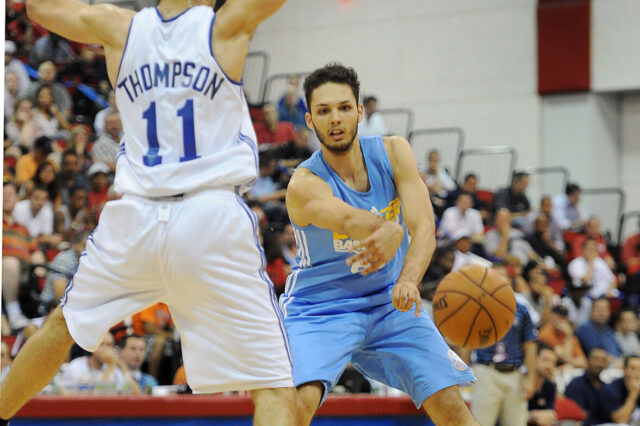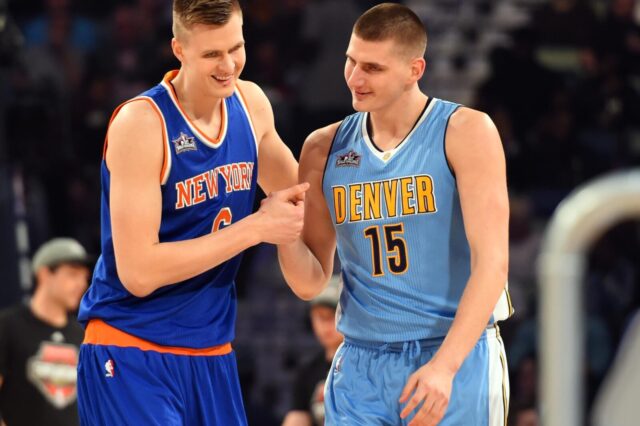This Friday, there will probably be some news about the 2019-20 NBA season. The NBA Board of Governors is having a call that day with commissioner Adam Silver and Director of the NBPA Michele Roberts to discuss scenarios that bring back the NBA season.
The league has circled Orlando and the Walt Disney World resort as the most likely venue for hosting teams and personnel as the league attempts to safely bring back basketball. There are a multitude of factors to consider, but all momentum points toward the NBA being willing to try to finish the season.
The biggest question now, once the NBA decided they wanted to play again and figured out a viable location, is how the actual basketball will look. With the playoff game schedule now likely pushed back to July as opposed to the normal mid April start, as well as millions in TV revenue still outstanding, the NBA is seeking out creative ways to bring back the regular season and/or the playoffs in a safe manner. Various options have been kicked around, from restarting the season and finishing as many games as possible before a normal playoff, to immediately starting the playoffs with the 16 teams currently in playoff position. Other formats have been considered to meet between the two extremes, from starting the playoffs immediately but with an extended playoff field, to even re-seeding all playoff teams in a 1 to 16 playoff field.
But the most interesting format relates to the FIFA World Cup that men’s and women’s soccer utilize to crown their eventual champion. 32 countries, all gaining entrance through play-in formats based on tournaments throughout the previous four years, are placed in eight groups of four teams. Each team plays the other three teams in their group, and the top two teams in each group advance to the 16-team single elimination bracket. After four rounds, a champion is crowned.
The NBA has looked into adopting a similar format for this year’s playoffs. Given that the NBA is concerned with losing TV revenue, this format would tack on additional games, meaning more money, and an interesting idea for fans to enjoy games they wouldn’t normally see.
My idea is to expand upon this format and create a fun, interesting way for the NBA to crown a champion in a year so clearly affected by factors outside the NBA’s control. Instead of trying to normalize a return to a unique season, the NBA could use this difficult period as an opportunity to test out alternative ways to play competitive basketball.
Let’s go through the step-by-step process:
This content is no longer available.
Step 1: Identify the tournament field
In the NBA’s discussions on expanding the playoff field, they have played around with going from the standard 16 teams to 18, 20, 22, or even 24 teams competing. Each team number presents its own unique set of advantages and disadvantages, but to me, 24 teams seems like the right call. Enough teams in the Western Conference were close enough to the 8 seed that they would be competitive in pool play games. In addition, more teams means more games before the playoffs wrap up.
Step 2: Seeding
There are a few ways to group 24 teams together, but the most interesting configuration would be four groups of six teams each, built using a serpentine format.
Here’s how the groups would pan out:
Current NBA standing in parentheses
Group A
- Milwaukee Bucks (1)
- Miami Heat (8)
- Oklahoma City Thunder (9)
- Orlando Magic (16)
- Portland Trail Blazers (17)
- Chicago Bulls (24)
Group B
- Los Angeles Lakers (2)
- Utah Jazz (7)
- Houston Rockets (10)
- Brooklyn Nets (15)
- New Orleans Pelicans (18)
- Charlotte Hornets (23)
Group C
- Toronto Raptors (3)
- Denver Nuggets (6)
- Indiana Pacers (11)
- Memphis Grizzlies (14)
- Sacramento Kings (19)
- Washington Wizards (22)
Group D
- Los Angeles Clippers (4)
- Boston Celtics (5)
- Philadelphia 76ers (12)
- Dallas Mavericks (13)
- San Antonio Spurs (20)
- Phoenix Suns (21)
Step 3: Warmup starts June 15th
There is at least moderate concern around the league about the players not having enough game time to get back to NBA game shape. NBA basketball is one of the most grueling physical feats in such a short period, and there is a high level of injury risk by reintroducing players into such a unique format over three months after they would have played their last game.
To adjust for that, teams would be given a four week training camp with scrimmages and exhibition games mixed in versus teams outside of an opponent’s group. For example, the Nuggets in Group C would scrimmage and have warmup games against teams in Group D, while the Lakers in Group B would undergo the same process against teams in Group A. That way, there’s little competitive advantage teams could face in playing teams from their own groups.
This warmup could also be reduced in length if a time crunch appears likely, but giving teams ample time to get ready seems like the best way to handle such a unique situation.
This content is no longer available.
Step 4: Group Play starts July 15th
As outlined above in Step 2, the 24 teams in the Group stage have been divided into four groups of six teams. Each team in the group would play the five other teams over the course of a two week period. That leads to 60 total games in a two-week span from July 15th to July 28th or so, which would be important revenue added for a league in need of manufacturing revenue from nowhere. The average number of games played in the first round of the playoffs ranges between 41 and 45 games over the last five years, meaning that introducing a group play tournament would tack on at least 15 extra games of TV revenue.
Other outlets have put out various proposals with differing methods and numbers of teams. The biggest concern championship caliber teams have with a group stage is getting upset in what amounts to the first round of the playoffs before players are completely back and ready to go following what will be too small of a tune-up period. A 20-team group play proposal surfaced yesterday, but turning that into 24 teams adds a below average team to every group that the best teams SHOULD be able to beat. Racking up an extra win helps shift the competitive balance back toward the best teams in such a scenario, despite the non-zero chance they could be upended prematurely.
Either way: four groups, six teams per group, five games for each team would be a fun way to give most teams’ fans something to root for after the season was dramatically altered, and opening up the field would give bubble teams an outside shot to crash the playoff picture. Some chaos in this case could be good.
Step 5: Elimination Play starts August 1st
After Group Play has concluded, the top two teams in each of the four groups based on record and head-to-head tiebreaker would advance to a standard seven game series format. With what is hopefully the best eight teams left standing, a return to normalcy and tradition would involve re-seeding the teams based on record prior to the league stoppage.
For example, let’s say the top two teams in each group advance except for the Boston Celtics in Group D. They were upset by the Philadelphia 76ers because Joel Embiid won games due to his physicality and interior presence. Boston was the 5 seed, so the teams seeded 1 to 4 wouldn’t change. The Denver Nuggets, currently seeded at 6, would move up to 5. The Utah Jazz would move from 7 to 6, the Miami Heat would move from 8 to 7, and the Sixers would then slide into the 8 seed. At that point, the playoff field would look as follows:
Elimination Play Field:
- Milwaukee Bucks (1) vs Philadelphia 76ers (8)
- Los Angeles Clippers (4) vs Denver Nuggets (5)
- Toronto Raptors (3) vs Utah Jazz (6)
- Los Angeles Lakers (2) vs Miami Heat (7)
At this point, the playoffs would be relatively normal. The winner of Bucks-Sixers would play the winner of Clippers-Nuggets. The winner of Raptors-Jazz would play the winner of Lakers-Heat. A champion would still have to win three seven-game playoff series’ in a row in order to be crowned, on top of advancing past Group Play. It would be grueling, but it would certainly be rewarding.
This step of the plan would take roughly six weeks to complete, finishing up on or around September 15th and avoiding the NFL calendar as much as possible. Ideally, the NBA playoffs would finish up around Labor Day on September 2nd, but that doesn’t seem viable in this particular plan unless the warmup time is reduced, Group Play games are cut, or there are Best-of-5 playoff series as opposed to Best-of-7 series.
It’s very possible that this proposal could be demolished due to the safety concerns of having 24 separate teams and personnel on the Disney campus for a six week period. After those six weeks, the number drops to eight teams rather quickly, but if there are players or team personnel that catch the virus in this environment, it would be difficult quarantine players and keep the process moving in a healthy, reasonable way.
Still, the NBA is going to try and find the best way to complete the season, and while doing so with just the 16 playoff teams seems like the safest way to go about it, there are unavoidable revenue problems that could affect the NBA for years to come if they don’t get this year right. Maximizing this season helps mitigate next year’s likely salary cap and luxury tax drop. It helps the NBA remain flexible with TV and entertainment packages that could push the sport forward for future generations.
Hell, additional revenue this year could prevent the Nuggets from using the amnesty clause to cut one of their rotation players in order to save money quickly.
Whatever the case may be, it looks like the playoffs are going to happen, and it will be interesting to see which direction the NBA decides to go. However the decision affects the Nuggets, we at Denver Stiffs will certainly cover it.


